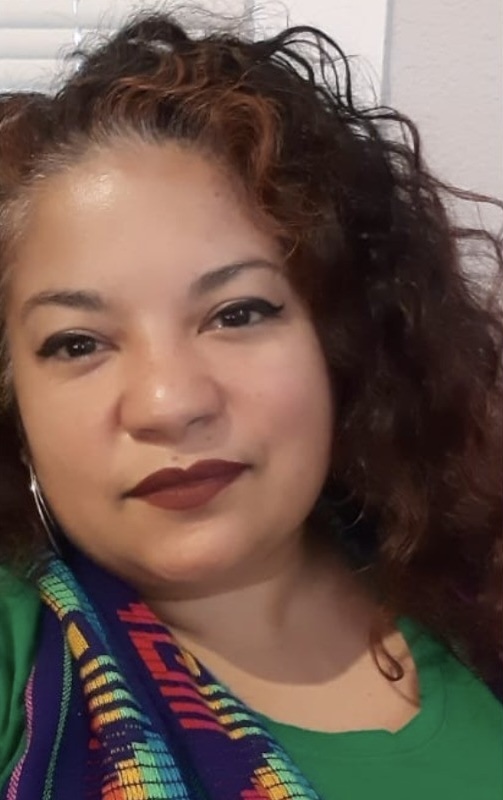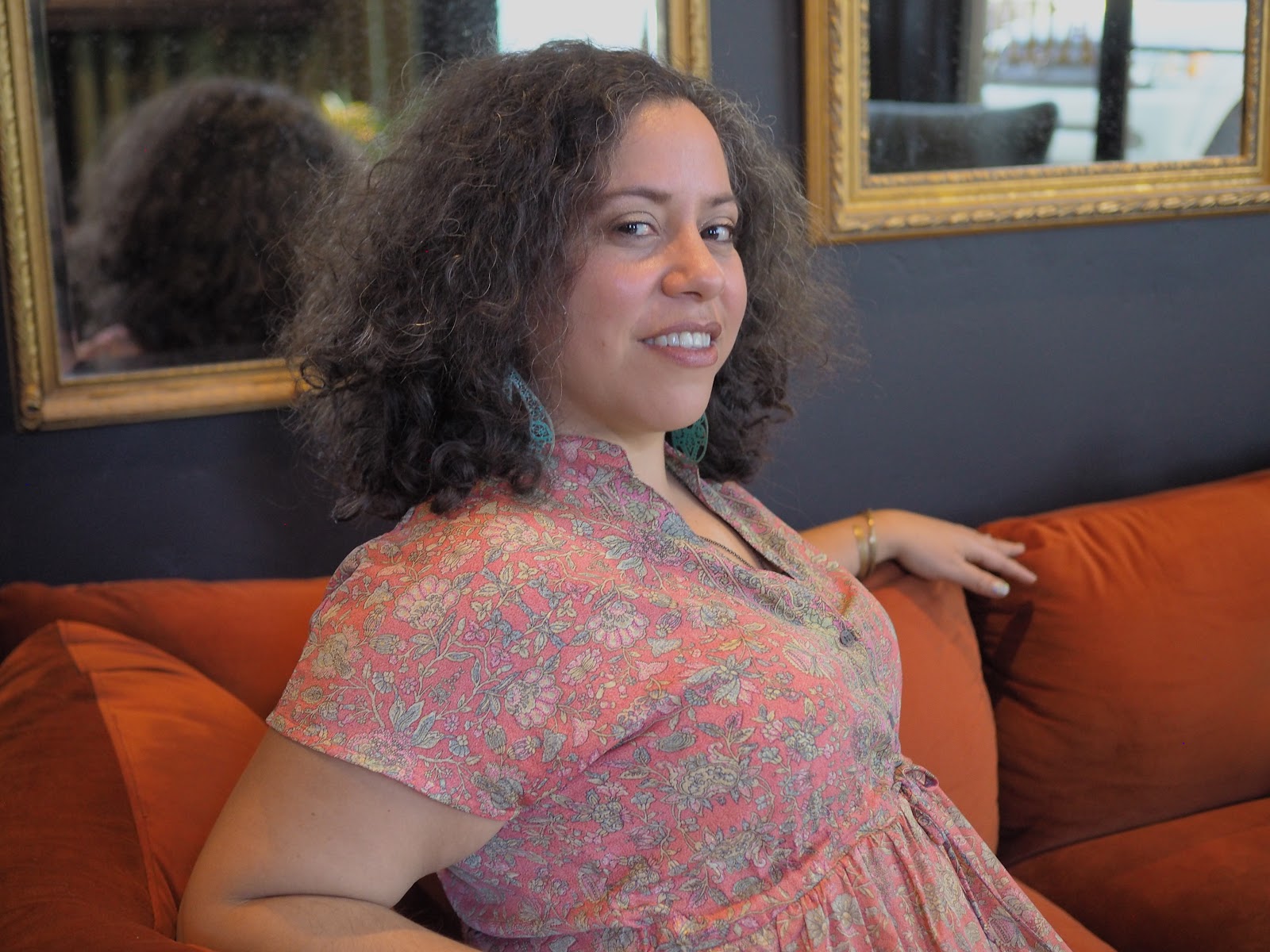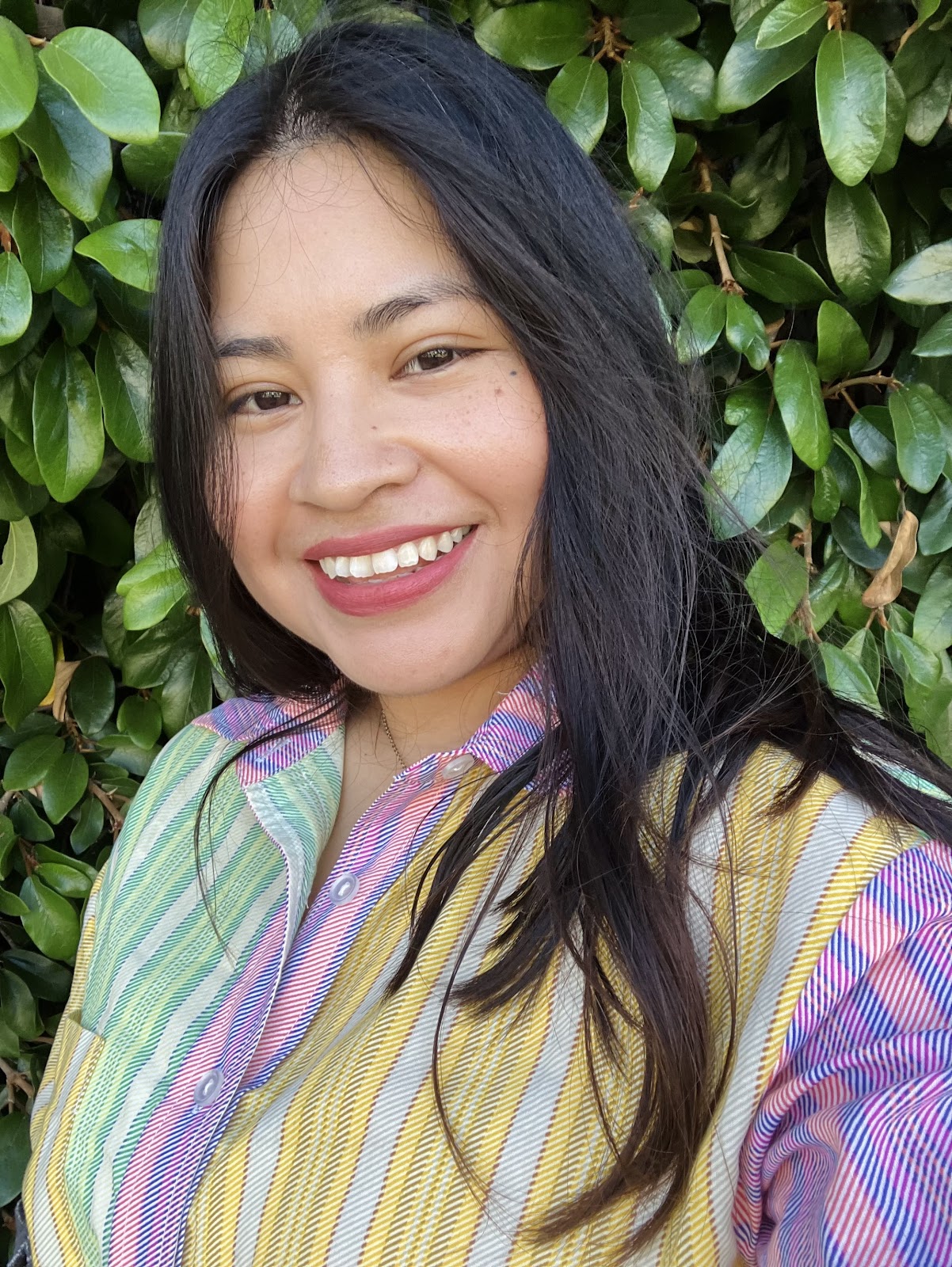Who are these people? For now, I must allow the fotos to be the story as I don't have all the names yet. In the third panel, upper right hand portrait, meet Laureate-designate Sebha Sarwar. Her Co-designate, Lester Graves Lennon, was unable to attend and read his published poem. In the middle panel, upper right hand portrait is Pauli Dutton, founder of the Laureate program in Altadena.
Next week, La Bloga-Tuesday features a review of the anthology.
Special Feature: Guest Columnist Xochitl-Julisa Bermejo and On-line Floricanto
Five Latina poets, Maya Chinchilla, Luivette Resto, Anatalia Vallez, Viktoria Valenzuela, and myself, traveled to New Orleans from across the county to present at the New Orleans Poetry Festival. Once there, we gathered with the sixth poet of our collective, Roxy Eve, who lives in the city and works in hospitality.
Only there for a short time, Chinchilla shared, “Initially, I couldn't help but feel a twinge of frustration knowing that my first visit to New Orleans would span a mere three days. However, thanks to the guidance of two members of our group who had previously explored the city, we were able to immerse ourselves in a survey of the city's cultural vibes.”
Chinchilla was right, most of our collective only had about two full days to both explore the city and attend the festival, but we made the most of it. Local highlights included pecan candied bacon from Elizabeth’s in Bywater, shopping for trinkets at the French Market, and being treated to a hometown crawfish boil and neighborhood ghost hunt thanks to Valenzuela’s high school friends, Paul, Molly, and their middle schooler, Magnus.
The next day, the whole family came to our panel, and it was a special joy of mine to perform my poem, “Interview with a Ghost Solider in the Peach Orchard,” for our ghost tour guide, Magnus.
Morning of our presentation, we made a writing date for 9am. Our Airbnb had the perfect round table, which we dubbed the séance table, where we could sit together and work. “Luivette Resto brought out her bruja literary deck of tarot cards, and we shared some time writing,” recalled Valenzuela. “To be writing new poems as medicine las Latinas” wasn’t something she expected, but that one hour of oracle cards, sharing, and writing felt like a bit of magic.
Vallez, who stayed with a friend and missed our morning writing session, was surprised at how little writing she did. “I barely opened my laptop or emails. Instead, I spent a lot of time at ease, taking in the sounds, smells and tastes. I was present and in my body. I really needed that reset.”
By noon Saturday, we all convened at the festival to sell and sign books with the FlowerSong Press table, thanks to the generosity of publisher, Edward Vidaurre.
As the organizer of this trip, I was worried that just one, 50-minute reading wouldn’t be enough of a reason to travel across the country. I wanted to make the journey worth it, so I asked Vidaurre if he might share his table with us for an hour, and he kindly agreed.
Resto, my collaborator and comadre, also worked on finding a location in the city for a second reading. Ultimately, that second reading didn’t work out this time, but that’s how things go.
Even our final line up lost two poets along the way due to life occurrences and commitments, which is why I chose to set up a gofundme for the trip. Crowdfunding isn’t something I typically use for my writing travels. Don’t get me wrong, I ask for support from my community in many ways to meet travel demands and costs. In the fall I created a DIY west coast book tour for my book, Incantation: Love Poems for Battle Sites (Mouthfeel Press), and I relied heavily on friends opening up their homes or inviting me into their classrooms.
I’m extremely thankful for those who stepped up in several ways to make my tour a reality. As poets, we want to share our poetry with the world. For me, it’s a vocation, and kind of like a missionary, it’s an endeavor that will almost always cost more than you earn. And, since I was asking 5-6 Latina poets to join me, knowing they have their own families, jobs, homes, and more to think of, I wanted to do something to make the journey a little easier.
35 people ended up donating, and all our poets got a little bit of help with travel costs. Even Eve, who didn’t travel for the event, received a small honorarium for her time, her poetry, and saying yes to performing alongside us. No poet was to be left out.
Eve said of the experience, “I was beyond honored to be considered for this reading as I am newly immersing myself into this writing journey. The whole squad, or as I affectionately refer to them ‘La Tribú de Titis Poetas’ took me under their wing immediately and committed to helping guide me in my new path of poetry.”
Hearing Eve’s poetry and seeing her shine was a highlight for many of us. “The way we all saw ourselves in Roxy, who is new in seeing herself as a writer, the way we all rallied around her and supported her, this is what this trip is about,” Resto shared.
Resto was the one to connect us to Eve. The two had little more than a friendly IG friendship based on a love of good wine, good food, and travel tips. Resto asked Eve over IG if she knew any local poets we could invite to read with us, and Eve shared that she wrote.
The connection between the two was just as powerful for Eve. “Luivette, my guide into this collective, ignited a fire with her voice and the piece she shared. It was the first time in a long time I felt seen in a piece of writing. This experience definitely will be influencing my commitment to honoring my voice as one that is valid to be heard.”
Together the six of us read 2-3 poems each and then chatted with a small but loving audience of about 15 people. I was excited to connect with a Colombian poet and an Argentinian poet in the room.
Resto and I had talked about this before leaving for our trip, that our author bios and presentations make us visible to those who are looking for community.
For Valenzuela, she took the small audience as fuel, “I am blessed to live in the barrios of San Antonio, TX where all of my neighbors and even company owners are Mexican-American and Indigenous ancestry. In New Orleans, it was glaring that we Latinas were marginalized when the audience that sat in on our panel were either close friends or Latino heritage people looking to hear some hint of community.”
It’s true we felt small among the bustle of the festival and the city, but finding other Latinx folks throughout our short stay became a highlight.
Chinchilla noted “the influx of migrants post-Hurricane Katrina.” “I offered my translation skills to a Cuban restaurant worker who was trying to buy ice from the Arab convenience store worker,” recalled Chinchilla. “And my friends found out that the workers behind the food counter were Salvadoran and Native American. The last morning, we even got to eat at a Honduran brunch spot eating the fanciest and tastiest baleadas of all time.”
“I was so moved by the other writers,” Resto said. “We are all so different as writers and where we are with our writing and lives. Even with the variety, I felt strongly connected with everyone and their stories. These women gave me permission to be vulnerable without judgment. That was moving and beautiful to me.”
Vallez said, “-- we were vibrant in our different personalities and we took care of each other and held each other like we've known one another our whole lives. I know we have something special and I can't wait for what's in store for us next.”
We ended our reading with a round of celebratory Tequila shots offered as a gift by Eve. In pure sommelier style, she hand-picked a bottle of Mijenta, a Latina owned company. From Mijenta’s mission: “Derived from ‘Mi Gente,’ which means ‘My People,’ Mijenta refers to a community of like-minded people who come together to celebrate life.”
Sharing a brindis with these hermanas was a perfect way to close our presentation. And after we left the festival, Chinchilla gushed at how “we had the privilege of breaking bread and swapping writerly tales with Kundiman poets Jane Wong, Sally Wen Mao, Tiana Nobile, and Cathy Linh Che.”
And so we continued to gather, be present with one another, and most importantly, laugh throughout our weekend. It’s what we now carry with us into our homes and jobs, with our families and students, and onto the page.
The selection of poems come from those we read at the New Orleans Poetry Festival on April 20, 2024. They are in the order in which we performed.
Overwhelming by Luivette Resto
“Personality affects the way a color is perceived on you. If you look best in strong colors and you have a very strong personality, the combination may be too much in some instances. Other people may find you overwhelming.” Conservative Chic: the 5-step program for dressing with style
overwhelming strong: the perfect name for the Macy’s fragrant section
overwhelming strong: the surprising amount of heavy things I can carry
overwhelming strong: what not to write in the cover letter
overwhelming strong: the resolve of mothers and caretakers
overwhelming strong: what I learned to survive because Audre Lorde was right
overwhelming: the amount of black outfits in my closet
from LBD’s to sweater turtlenecks my children affectionately call my poetry outfit
overwhelming: what teaching was like in 2020
overwhelming: the increasing number of children cradled then buried in Gaza
strong: what my therapist reminds me of every other Saturday
strong: what I am tired of being called every other Saturday
when all I want is to come apart like paper mache in the rain
Oh Say Can You See by Viktoria Valenzuela
By the dawn's early light, I think of skin; I think of how
Light can shine through my eyelids no matter how hard I close them.
I question, do they see
a lampshade at a neo-Nazi party?
When I think of eyelids
I pet mine with flower petals soaking.
We soak up the sun's rays to make chlorophyll.
Am I a daisy pushed up after someone has died?
When I think of flower petals
I think of honey bees hovering over the sex organs of flowers
and tongues
of black bears. Am I a black bear starving in the forest for lack of bees?
When I think of black bears
I think of polar bears who have white fur but black skin.
Am I a polar bear starving in the Arctic for lack of ice
and seal prey? When I think of I.C.E. I think of brown
skin, that looks just like mine, trying to make it in America.
Am I American if neo-Nazis are running America?
When I think of America, my body aches
for something more protective than skin. Skin is only skin deep.
Skin is only skin
Deep. Black-Red-Yellow-Brown as brown can be.
Tres Pasos by Maya Chinchilla
From Cha Cha Files: A Chapina Poética
Read with improvisations at the New Orleans Poetry Festival 2024
On first beat hit the body remembers
chest lifts up to sky
tentative beginnings
ask permission
feet talk to earth north west south east
kids elders women men more spirits than names
drum boom bada boom bada boom boom boom
blood pulse heart time rhythm
the dance is the conversation
in your body out of your head
ba boom ba boom bada boom
boom boom boom
ba boom ba boom bada boom
boom boom boom
a Chapina among Mexica
Folkoric gendered conversations
colonial separations haughty hybrids
rhythmic violins
feet pound heel toe heel toe
the zapateado step I never forgot
she pounded these moves into my head every day after school
down grocery store aisles
between burger and fries king taco
in parking lots
at the fabric store at the movies
don't look at your feet stand up straight
imagine nails echo sound from heels of shoes
ribbon thread thru your spine hold up your head
we danced for fun then to build
after riots fired anger at convenience stores
took streets locked doors behind tv screens
nineties early spring
adult admin looked to fresh faces
for multi-culti bandaids
cause kids know what’s up
know more about your kids than you do
we took scraps student assembled
tejiendo culture baile flor y canto
danced numbers
Azteca to Sinaloa to Rumba
to Caifanes Timberiche y Chayanne
dance the story
back to Porfirio Diaz dictated hyper Mexicaness
She was grace
victorian posture and ruffles
waist up Guadalajara tall
arms move skirt swirling half circles
slice air into waves
filling space with ribboned hems
no one remembers the names
of the men that danced around her.
Bomba puerto invitation rico
repite: en la punta del pie
marca el paso
Yubá Sicá Cuembé Calindá Hoyo Mula Holandés
women on the drum disrupting a previous beat
shaking out the flesh feeling new parts of the body
bay area communing together in the batey/circle
the call and the response
the smile on her face when she says
Me encanta la bomba. Me cura.
both dreamy and assured
muscle memory spirits come through
te invitan or you jump in
grounded thru the hips chest high arms elbow tip of foot
tirando piquetes
throwing the conversation back to the drum
bámbula is to remember
respeto release an africanborinquen survival story
4. On first beat hit the body remembers
the way a bordered people travel forced
no tan islada
movement passes culture
stand up tall lift chest to sky
defy forced downward gaze
bending over now for flexibility and strategy
with lessons from a humble earth
rhythm is your voice. Let her speak.
Feet document story. Let them speak.
Base boom. Let you speak.
In the circle calling. Habla Habla. Let us speak.
Habla.
The body remembers
If La Llorona Had a Hashtag by Xochitl-Julisa Bermejo
If la llorona werealways very quietno one would call heran evil woman
- Gina Valdés, Bridges and Borders
no one would know her.
The story would be no story,
just as there is no name.
If La Llorona had a hashtag
it might be #mishijos,
or #remembermishijos,
or #somosamoreterno.
Then maybe citizens
might question
how her children drowned
and by whose hands.
Because if I know anything,
it wasn’t by her own.
History teaches me
the guilty like their laws
so the guilty can sleep well
and the guilty feel just
in their beds, in their homes,
in their city lines, and maps.
But the guilty don’t cry,
even as they say, “Thoughts
& Prayers,” for our babies
born open water.
Intense, Tense, Prone.
Algunas veces las palabras se me traban, se me traban por tensa, soy propensa a errar,
especialmente cuando hay emociones intensas.
the words because sometimes neither tongue feels my own.
Intensa, Tensa, Propensa.
Intense, Tense.
Emociones tan intensas. I cannot capture them in either language. Te amo is so much more than
an I love you and I love you requires so much effort.
people.
of how hard my heart beats, how hard I love.
From The Most Spectacular Mistake by Anatalia Vallez
As a fetus my mother inhaled love
it lingered in her vocal chords
then traveled to her stomach
through her umbilical cord
and into me
it now lives between my stomach and diaphragm
perhaps that’s why I exist
to exhale what was trapped in my mother’s throat
Luivette Resto is an award-winning poet, a mother of 3 revolutionary humans, and a middle school English teacher. She was born in Aguas Buenas, Puerto Rico but proudly raised in the Bronx. She is a CantoMundo and Macondo Fellow and a Pushcart Prize nominee. Her two books of poetry Unfinished Portrait and Ascension have been published by Tía Chucha Press. Her third poetry collection Living on Islands Not Found on Maps was published by FlowerSong Press in 2022. Her work has been mentioned in the LA Times, Ms. Magazine, and North American Review. She sits on the board for Women Who Submit, and she was recently appointed associate editor for Tía Chucha Press.
Viktoria Valenzuela holds a master of arts degree in English literature. She is the executive director/associate editor at Voices de la Luna Magazine, an inaugural Zoeglossia fellow, and a Macondista and has served as the San Antonio chapter co-lead of Women Who Submit as well as the organizer for 100 Thousand Poets for Change: San Antonio. Valenzuela's poetry and essays have appeared in Puro Chicanx Writers of the 21st Century Anthology (published by Cutthroat, a Journal of the Arts, 2020); We Are Not Your Metaphor: A Disability Poetry Anthology (Squares & Rebels, 2019); Raising Mothers; Mutha Magazine; and CONTRA: Texas Poets Speak Out (FlowerSong Press, 2020). Valenzuela and her husband, poet Vincent Cooper, share six children and live in San Antonio, Texas.
Maya Chinchilla is a Guatemalan, Bay Area-based writer, video artist, educator and author of “The Cha Cha Files: A Chapina Poética.” Maya received her MFA in English and Creative Writing from Mills College and her undergraduate degree from University of California, Santa Cruz, where she also founded and co-edited the annual publication, La Revista. Maya writes and performs poetry that explores themes of historical memory, heartbreak, tenderness, sexuality, and alternative futures. Her work —sassy, witty, performative, and self-aware— draws on a tradition of truth-telling and poking fun at the wounds we carry.
Xochitl-Julisa Bermejo is the daughter of Mexican immigrants and author of Posada: Offerings of Witness and Refuge (Sundress Publications) and Incantation: Love Poems for Battle Sites (Mouthfeel Press). A former Steinbeck Fellow and Poets & Writers California Writers Exchange winner, she’s received residencies from Hedgebrook, Ragdale, Jentel, Yefe Nof, and National Parks Arts Foundation in partnership with Gettysburg National Military Park and Poetry Foundation. She teaches poetry and creative writing with Antioch University, MFA and UCLA Extension. Bermejo is the director of Women Who Submit. Inspired by her Chicana identity, she works to cultivate love and comfort in chaotic times.
Roxy Eve (she/they) is a Boricua poet based in New Orleans whose love of poetry began at a young age. As an adult, her writing focuses on themes of lived experience as a Boricua of the diaspora, thriving as a queer femme, and being an eldest daughter of immigrants. Roxy Eve’s poetry is a conversation through the Spanglish lens, always teetering between both Spanish & English but never fully occupying either. She is inspired by the works of Yesika Salgado and Elizabet Velasquez. When she isn’t weaving impassioned words, Roxy Eve makes spirits bright as a wine & hospitality professional.
Anatalia Vallez is a writer, actor and creative alchemist from Orange County, California with roots in Guerrero Mexico. Her work centers around self love, ancestral connections and social justice. She is the author of a poetry collection: The Most Spectacular Mistake (FlowerSong Press, 2020) featured in the LA Times, LibroMobile and KPFK Radio’s Nuestra Voz. Anatalia has also had some of her plays produced including Las Sirenas, a story about student activism and Chicana mermaids. She has a BA in Sociology from UC Berkeley and an MFA in TV Film and Theatre from Cal State LA.
Photos by Fernanda Meier at FernandaMeier.com
In addition to being a photographer, Fernanda Meier is a world traveler, social media maven, culture & content curator, and education evangelist with experience copywriting, DEI & staff development, and digital marketing strategy. Born in Accra, Ghana, Fernanda has lived in New York, Georgia, Florida, Texas, Wisconsin, and Puerto Rico and now New Orleans, since moving to the United States. She thrives while working remotely as a digital nomad, and creatively incorporates her global adventures into her work while leveraging her diverse experiences and knowledge to best serve her clients' needs.
Fernanda is passionate about social justice, decolonization, environmental conservation, and making the world a better place for future generations.

































